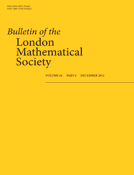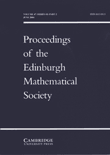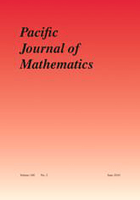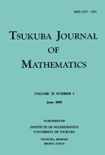
European Journal of Mathematics
Scope & Guideline
Bridging Theory and Practice in Mathematics
Introduction
Aims and Scopes
- Algebra and Number Theory:
Research in this area includes studies on algebraic structures such as rings, modules, and algebras, along with number theory topics including prime ideals and algebraic number theory. - Geometry and Topology:
The journal features papers exploring geometric structures, including differential geometry, algebraic geometry, and topology, focusing on the properties and applications of various geometric entities. - Analysis and Functional Analysis:
Papers in this section cover real and complex analysis, functional analysis, and operator theory, emphasizing the theoretical underpinnings and applications of analytical methods. - Applied Mathematics and Computational Methods:
This area encompasses numerical methods, mathematical modeling, and computational techniques applied to real-world problems across various scientific and engineering disciplines. - Graph Theory and Combinatorics:
Research involving properties and applications of graphs, combinatorial structures, and their mathematical implications is a significant focus of the journal. - Differential Equations and Dynamical Systems:
The journal includes studies on ordinary and partial differential equations, dynamical systems, and their qualitative and quantitative analyses. - Mathematical Physics and Interdisciplinary Applications:
Papers exploring the intersection of mathematics with physics and other disciplines, providing mathematical insights into physical phenomena and interdisciplinary applications.
Trending and Emerging
- Interdisciplinary Applications of Mathematics:
There is a growing trend of papers exploring the application of mathematical theories and methods to fields such as biology, economics, and engineering, indicating a shift towards interdisciplinary research. - Advanced Computational Techniques:
The journal has seen an increase in publications focused on advanced computational methods, including machine learning and numerical simulations, reflecting the integration of computer science with mathematics. - Nonlinear Dynamics and Chaos Theory:
Research in nonlinear dynamics and chaos theory is on the rise, highlighting an increased interest in understanding complex systems and their behaviors. - Fractional Calculus and Applications:
The emergence of fractional calculus as a significant area of study is evident, with more papers dedicated to its applications in various fields, including physics and engineering. - Mathematical Modeling of Real-World Problems:
There is a notable increase in research that emphasizes mathematical modeling to address real-world issues, particularly in health sciences, environmental studies, and economic forecasting. - Algebraic Structures with Applications:
Emerging research on specialized algebraic structures, such as superalgebras and hom-algebras, suggests a trend towards exploring their applications in theoretical and applied contexts.
Declining or Waning
- Classical Analysis Techniques:
There has been a decline in the number of publications focused on classical analysis techniques such as elementary methods in real analysis, suggesting a shift towards more modern and abstract approaches. - Elementary Number Theory:
Research papers that delve into elementary number theory topics have become less frequent, possibly due to a growing emphasis on more complex algebraic structures and computational methods. - Basic Graph Theory:
While graph theory remains a vital field, basic studies on simple graph properties and structures are declining, indicating a shift towards more advanced topics or applications in graph theory. - Traditional Combinatorial Techniques:
The journal has seen fewer papers utilizing traditional combinatorial methods, as researchers increasingly adopt probabilistic and geometric approaches. - Standard Algebraic Structures:
Research on standard algebraic structures, such as basic group theory, is less frequently featured, possibly reflecting a move towards more specialized or applied algebraic research.
Similar Journals

Turkish Journal of Mathematics
Exploring the Depths of Mathematical KnowledgeTurkish Journal of Mathematics is a prestigious academic publication dedicated to the advancement of mathematical research across a variety of subfields. Established in 1995 and published by the Tubitak Scientific & Technological Research Council Turkey, this journal has built a solid reputation, especially noted for its significant contributions to the field over the years, with its convergence spanning from 1995 to 2002 and again from 2006 to 2024. The journal, which holds a commendable Q2 ranking in Mathematics (miscellaneous) and is positioned in the 66th percentile of Scopus rankings for General Mathematics, aims to disseminate high-quality original research, reviews, and innovative methodologies to advance both theoretical and applied mathematics. Researchers, professionals, and students alike will find invaluable resources within its pages, providing insights that are pivotal for academic and practical applications in mathematics. Although it does not currently offer open access options, the journal remains an essential platform for those looking to engage with the forefront of mathematical inquiry.

BULLETIN OF THE LONDON MATHEMATICAL SOCIETY
Cultivating Knowledge and Innovation in MathematicsThe BULLETIN OF THE LONDON MATHEMATICAL SOCIETY, published by Wiley, is a distinguished journal that serves as a vital resource in the field of mathematics. With its ISSN 0024-6093 and E-ISSN 1469-2120, this journal has consistently provided a platform for innovative research and scholarly discourse since its inception in 1969. Recognized for its quality, it currently holds an impressive Q1 ranking in the mathematics category, a testament to its significance in disseminating influential findings and trends in the mathematical sciences. Researchers and practitioners can rely on the BULLETIN for its comprehensive coverage of both theoretical and applied mathematics, which caters to a diverse audience ranging from professionals to students alike. Though it does not currently offer Open Access options, its articles can be accessed through institutional subscriptions, ensuring that significant works reach the academic community effectively. With contributions that span over five decades, the journal continues to shape mathematical research and inspire future advancements in the discipline.

Research in the Mathematical Sciences
Advancing Knowledge in Mathematical DisciplinesResearch in the Mathematical Sciences is a prestigious journal published by Springer International Publishing AG, specializing in a diverse range of mathematical disciplines. With an ISSN of 2522-0144 and an E-ISSN of 2197-9847, this journal operates out of Switzerland and has established a reputation for excellence in research dissemination since its inception in 2014. The journal is currently ranked in the highly regarded Q2 quartile for Applied Mathematics, Computational Mathematics, and Mathematics (miscellaneous), along with a Q3 rank in Theoretical Computer Science, reflecting its substantial influence within the academic community. Researchers will find great value in this journal as it features high-quality, peer-reviewed articles that contribute to the advancement of mathematical sciences. The journal promotes open access options, facilitating greater accessibility to innovative research findings. With its comprehensive scope and strong Scopus rankings, Research in the Mathematical Sciences serves as an essential resource for academics, professionals, and students eager to stay at the forefront of mathematical research and its applications.

Analele Stiintifice ale Universitatii Ovidius Constanta-Seria Matematica
Navigating the Future of Mathematics with Rigorous ScholarshipAnalele Stiintifice ale Universitatii Ovidius Constanta-Seria Matematica is a prominent open-access journal established by OVIDIUS UNIV PRESS in Romania, dedicated to advancing the fields of mathematics, specifically in Analysis and Applied Mathematics. Since its inception, the journal has emphasized the dissemination of high-quality research, making it accessible to a global audience. With an ISSN of 1224-1784 and E-ISSN 1844-0835, it has positioned itself within the academic community, achieving a respectable Q3 ranking in both analysis and applied mathematics in 2023, reflecting its commitment to rigorous scholarship. The journal spans a considerable publication window from 2009 to 2024, catering to the ongoing developments in mathematical sciences and their applications. Researchers, professionals, and students alike will find valuable insights and contributions that enrich their understanding and foster collaboration within the mathematical community. The journal's headquarters is based at the Faculty of Mathematics & Computer Science, Bulevardul Mamaia 124, Constanta, Romania.

PROCEEDINGS OF THE EDINBURGH MATHEMATICAL SOCIETY
Connecting scholars through groundbreaking discoveries.PROCEEDINGS OF THE EDINBURGH MATHEMATICAL SOCIETY, published by Cambridge University Press, stands as a cornerstone within the realm of mathematical research, providing a platform for original papers that push the boundaries of various mathematical disciplines. With a rich history dating back to 1883, this journal has evolved through several converged years, reflecting the dynamic nature of mathematical inquiry. As a Q2 category journal in the field of Mathematics (miscellaneous) according to the latest rankings, it situates itself within the upper tier of academic publications, offering an essential resource for researchers and professionals alike. While it currently does not offer open access options, the journal's contributions are invaluable, facilitating dialogue and collaboration among scholars. The journal's commitment to advancing mathematical knowledge makes it a vital publication for those engaged in the study and application of mathematical theories and principles.

PACIFIC JOURNAL OF MATHEMATICS
Exploring the Depths of Mathematics with Rigorous ScholarshipThe PACIFIC JOURNAL OF MATHEMATICS, established in 1951 and published by Mathematical Sciences Publishers, is a premier peer-reviewed journal in the field of mathematics, renowned for its rigorous scholarship and impactful research contributions. With an HIndex that reflects its sustained academic influence, this journal has been categorized within the Q1 quartile in the field of mathematics (miscellaneous) as of 2023, showcasing its position among the top-tier mathematics journals globally. Although the journal operates under a traditional subscription model rather than an Open Access format, it remains dedicated to disseminating original research that spans various domains within mathematics. Researchers, professionals, and students alike will find the journal's breadth of topics and commitment to quality work instrumental in advancing their understanding and exploration of mathematical concepts. This esteemed journal continues to thrive as a vital resource for the mathematical community through its comprehensive collection of articles from a diverse range of mathematical disciplines, thus maintaining a significant role in shaping the future of mathematical inquiry.

Pure and Applied Mathematics Quarterly
Connecting Mathematicians Through Quality ResearchPure and Applied Mathematics Quarterly is a prestigious journal published by INT PRESS BOSTON, INC, focusing on the diverse and evolving field of mathematics. Since its inception in 2007, this journal has grown significantly, currently holding a Q1 ranking in the Mathematics (Miscellaneous) category for 2023, positioning it among the leading publications in the discipline. With a commitment to publishing high-quality research, Pure and Applied Mathematics Quarterly fosters innovation and dialogue within the mathematical community by providing a platform for theoretical advancements and practical applications. The journal remains accessible to researchers and professionals through its ISSN 1558-8599 and E-ISSN 1558-8602, although it does not currently offer open access. As a vital resource for mathematicians, educators, and students, this journal endeavors to expand the frontiers of mathematical knowledge and contribute to the academic dialogue surrounding this fundamental science.

PUBLICATIONES MATHEMATICAE DEBRECEN
Unveiling New Perspectives in MathematicsPublicationes Mathematicae Debrecen is a renowned international journal published by the University of Debrecen, Institute of Mathematics, situated in Hungary. This journal, with both ISSN 0033-3883 and E-ISSN 2064-2849, has established itself in the field of mathematics since its inception, with coverage extending from 1997 to 2024. Recognized for its rigorous academic standards, it currently holds a Q3 ranking in the mathematics (miscellaneous) category for 2023 and ranks at the 42nd percentile among general mathematics journals in Scopus. Publicationes Mathematicae Debrecen aims to disseminate high-quality research across various areas of mathematics, contributing to the advancement of knowledge and practice in this dynamic field. Although it is not an open-access journal, its readers can access a wealth of scholarly work that addresses both theoretical and applied mathematical issues, making it an invaluable resource for researchers, professionals, and students alike.

Tsukuba Journal of Mathematics
Elevating the Discourse in Mathematics for Global ImpactTsukuba Journal of Mathematics is a distinguished publication dedicated to advancing the field of mathematics through the dissemination of innovative research and comprehensive studies. Published by the University of Tsukuba, Department of Mathematics, this journal serves as a vital platform for mathematicians, researchers, and students to engage with cutting-edge mathematical theories and methodologies. Although currently not available as an open-access journal, it maintains a strong academic presence, contributing significantly to the global mathematical landscape. The journal invites submissions across various branches of mathematics, aiming to foster scholarly communication and collaboration. The ISSN 0387-4982 and the E-ISSN 2423-821X further establish its credibility and accessibility among the academic community, supporting its critical objective of facilitating high-quality research output. Situated in Tsukuba, Japan, a hub for scientific research and development, the Tsukuba Journal of Mathematics is committed to bridging gaps in mathematical knowledge and encouraging exploration of novel ideas.

RENDICONTI DEL SEMINARIO MATEMATICO DELLA UNIVERSITA DI PADOVA
Elevating mathematical discourse through open access scholarship.RENDICONTI DEL SEMINARIO MATEMATICO DELLA UNIVERSITA DI PADOVA, published by the European Mathematical Society, stands as a notable open-access journal with a rich history in disseminating research across various domains of mathematics. With an ISSN of 0041-8994 and E-ISSN 2240-2926, this journal has embraced open access since 2023, significantly enhancing its visibility and accessibility to a global audience. Situated in Germany, its publishing house is based at Technical University Berlin, which emphasizes its academic roots and dedication to fostering mathematical research. The journal features a quartile ranking of Q3 across multiple categories including Algebra and Number Theory, Analysis, Geometry and Topology, and Mathematical Physics as of 2023, indicating a vibrant contribution to the field, despite its challenge in specific rankings. Researchers, professionals, and students alike will find in this journal a platform for innovative ideas and significant findings that are crucial to the evolution of modern mathematics.